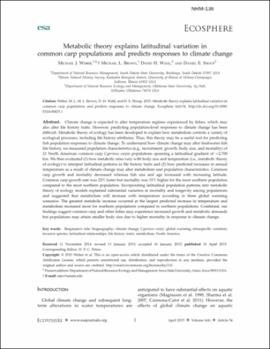| dc.contributor.author | Weber, Michael J. | |
| dc.contributor.author | Brown, Michael L. | |
| dc.contributor.author | Wahl, David H. | |
| dc.contributor.author | Shoup, Daniel E. | |
| dc.date.accessioned | 2019-08-22T17:51:01Z | |
| dc.date.available | 2019-08-22T17:51:01Z | |
| dc.date.issued | 2015-04-14 | |
| dc.identifier | oksd_weber_metabolictheory_2015 | |
| dc.identifier.citation | Weber, M. J., Brown, M. L., Wahl, D. H., & Shoup, D. E. (2015). Metabolic theory explains latitudinal variation in common carp populations and predicts responses to climate change. Ecosphere, 6(4), Article 54. https://doi.org/10.1890/ES14-00435.1 | |
| dc.identifier.uri | https://hdl.handle.net/11244/321260 | |
| dc.description.abstract | Climate change is expected to alter temperature regimes experienced by fishes, which may also alter life history traits. However, predicting population-level responses to climate change has been difficult. Metabolic theory of ecology has been developed to explain how metabolism controls a variety of ecological processes, including life history attributes. Thus, this theory may be a useful tool for predicting fish population responses to climate change. To understand how climate change may alter freshwater fish life history, we measured population characteristics (e.g., recruitment, growth, body size, and mortality) of 21 North American common carp Cyprinus carpio populations spanning a latitudinal gradient of >2,700 km. We then evaluated (1) how metabolic rates vary with body size and temperature (i.e., metabolic theory of ecology) to interpret latitudinal patterns in life history traits and (2) how predicted increases in annual temperature as a result of climate change may alter metabolism and population characteristics. Common carp growth and mortality decreased whereas fish size and age increased with increasing latitude. Common carp growth rate was 22% faster but mortality was 31% higher for the most southern population compared to the most northern population. Incorporating latitudinal population patterns into metabolic theory of ecology models explained substantial variation in mortality and longevity among populations and suggested that metabolism will increase with temperature according to three global warming scenarios. The greatest metabolic increase occurred at the largest predicted increase in temperature and metabolism increased more for southern populations compared to northern populations. Combined, our findings suggest common carp and other fishes may experience increased growth and metabolic demands but populations may attain smaller body size due to higher mortality in response to climate change. | |
| dc.format | application/pdf | |
| dc.language | en_US | |
| dc.publisher | Ecological Society of America | |
| dc.rights | This material has been previously published. In the Oklahoma State University Library's institutional repository this version is made available through the open access principles and the terms of agreement/consent between the author(s) and the publisher. The permission policy on the use, reproduction or distribution of the material falls under fair use for educational, scholarship, and research purposes. Contact Digital Resources and Discovery Services at lib-dls@okstate.edu or 405-744-9161 for further information. | |
| dc.title | Metabolic theory explains latitudinal variation in common carp populations and predicts responses to climate change | |
| osu.filename | oksd_weber_metabolictheory_2015.pdf | |
| dc.description.peerreview | Peer reviewed | |
| dc.identifier.doi | 10.1890/ES14-00435.1 | |
| dc.description.department | Natural Resource Ecology and Management | |
| dc.type.genre | Article | |
| dc.type.material | Text | |
| dc.subject.keywords | bergmann's rule | |
| dc.subject.keywords | biogeography | |
| dc.subject.keywords | climate change | |
| dc.subject.keywords | cyprinus carpio | |
| dc.subject.keywords | global warming | |
| dc.subject.keywords | intraspecific variation | |
| dc.subject.keywords | invasive species | |
| dc.subject.keywords | latitudinal relationships | |
| dc.subject.keywords | life history traits | |
| dc.subject.keywords | metabolism | |
| dc.subject.keywords | north america | |
